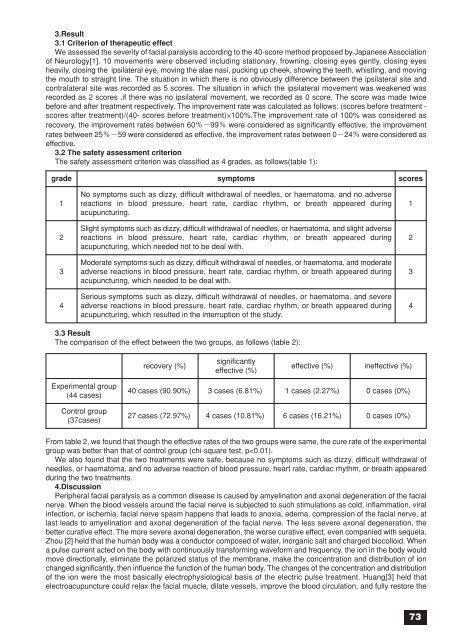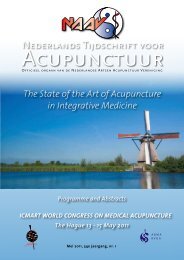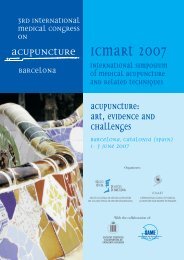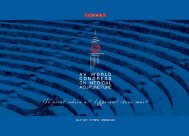Congress Abstracts full PDF - International Council of Medical ...
Congress Abstracts full PDF - International Council of Medical ...
Congress Abstracts full PDF - International Council of Medical ...
Create successful ePaper yourself
Turn your PDF publications into a flip-book with our unique Google optimized e-Paper software.
3.Result<br />
3.1 Criterion <strong>of</strong> therapeutic effect<br />
We assessed the severity <strong>of</strong> facial paralysis according to the 40-score method proposed by Japanese Association<br />
<strong>of</strong> Neurology[1]. 10 movements were observed including stationary, frowning, closing eyes gently, closing eyes<br />
heavily, closing the ipsilateral eye, moving the alae nasi, pucking up cheek, showing the teeth, whistling, and moving<br />
the mouth to straight line. The situation in which there is no obviously difference between the ipsilateral site and<br />
contralateral site was recorded as 5 scores. The situation in which the ipsilateral movement was weakened was<br />
recorded as 2 scores ,if there was no ipsilateral movement, we recorded as 0 score. The score was made twice<br />
before and after treatment respectively. The improvement rate was calculated as follows: (scores before treatment -<br />
scores after treatment)/(40- scores before treatment)×100%.The improvement rate <strong>of</strong> 100% was considered as<br />
recovery, the improvement rates between 60%-99% were considered as significantly effective, the improvement<br />
rates between 25%-59 were considered as effective, the improvement rates between 0-24% were considered as<br />
effective.<br />
3.2 The safety assessment criterion<br />
The safety assessment criterion was classified as 4 grades, as follows(table 1):<br />
grade symptoms scores<br />
1<br />
2<br />
3<br />
4<br />
No symptoms such as dizzy, difficult withdrawal <strong>of</strong> needles, or haematoma, and no adverse<br />
reactions in blood pressure, heart rate, cardiac rhythm, or breath appeared during<br />
acupuncturing.<br />
Slight symptoms such as dizzy, difficult withdrawal <strong>of</strong> needles, or haematoma, and slight adverse<br />
reactions in blood pressure, heart rate, cardiac rhythm, or breath appeared during<br />
acupuncturing, which needed not to be deal with.<br />
Moderate symptoms such as dizzy, difficult withdrawal <strong>of</strong> needles, or haematoma, and moderate<br />
adverse reactions in blood pressure, heart rate, cardiac rhythm, or breath appeared during<br />
acupuncturing, which needed to be deal with.<br />
Serious symptoms such as dizzy, difficult withdrawal <strong>of</strong> needles, or haematoma, and severe<br />
adverse reactions in blood pressure, heart rate, cardiac rhythm, or breath appeared during<br />
acupuncturing, which resulted in the interruption <strong>of</strong> the study.<br />
1<br />
2<br />
3<br />
4<br />
3.3 Result<br />
The comparison <strong>of</strong> the effect between the two groups, as follows (table 2):<br />
recovery (%)<br />
significantly<br />
effective (%)<br />
effective (%) ineffective (%)<br />
Experimental group<br />
(44 cases)<br />
Control group<br />
(37cases)<br />
40 cases (90.90%) 3 cases (6.81%) 1 cases (2.27%) 0 cases (0%)<br />
27 cases (72.97%) 4 cases (10.81%) 6 cases (16.21%) 0 cases (0%)<br />
From table 2, we found that though the effective rates <strong>of</strong> the two groups were same, the cure rate <strong>of</strong> the experimental<br />
group was better than that <strong>of</strong> control group (chi-square test, p







